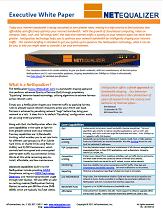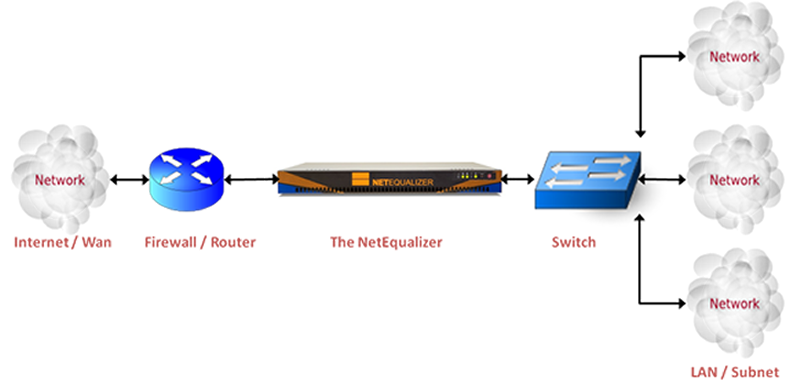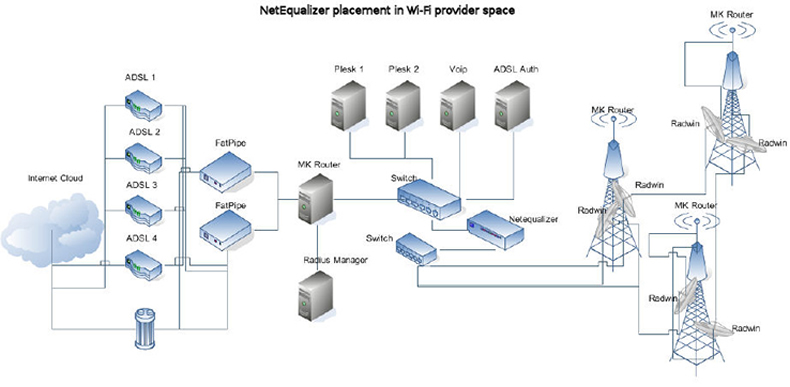For more support related questions and answers please visit the NetEqualizer Blog Support Page.Frequently Asked Questions (FAQs)
Learn more...
![]()

View Executive White Paper
NetEqualizer is an automated traffic shaping appliance that works like putting a traffic cop on a freeway interchange to ensure that everybody gets on and off without creating gridlock. The left turners, the right turners, and the aggressive drivers who would otherwise cut in line behave much better when the traffic officer is there. The router between the Internet and your subnet is just such an interchange, and NetEqualizer is the traffic cop. Internally, NetEqualizer operates similarly to a packet sniffer. It examines Internet data by listening to all traffic on an Internet segment, typically a trunk between a group of users and the Internet. As each Internet packet comes by on the trunk, an arbitrator examines the packet and learns to whom the packet is going—the end user. NetEqualizer keeps a small database of the activity going on over an Internet segment. Then, using a set of predefined rules, it determines which users are consuming excessive bandwidth. During periods of peak network usage, data rates to users who are consuming excessive amounts of bandwidth are imperceptibly slowed as needed to alleviate congestion. Saad Khan 1. No Policy Libraries 2. Bi-directional Traffic Shaping 3. Cost-Effective Locate NetEqualizer between your network and the Internet. Tune the default settings and it will immediately start relieving congestion. This plug-and-play ability is the driving vision and design behind NetEqualizer. Yes, there are “traditional” optional administration features offered, but we cannot overemphasize the importance of the turn key concept. Typical NetEqualizer Installation Typical WiFi NetEqualizer Installation Any organization that purchases bulk Internet access and redistributes it to a group of users, including corporations, regional service providers, universities, hotels, etc., can benefit from installing a NetEqualizer on their Internet link. Internet Service Providers (ISPs), like phone companies, rely on the fact that only a small percentage of their customers will be actively using bandwidth at any moment in time and, therefore, most of them have oversold their networks and do not have enough bandwidth to meet peak demands. Economics dictate that regional ISPs who purchase their bandwidth from backbone service providers perform a juggling act between the cost of bandwidth and meeting the service expectations of their customers. Inevitably, some percentage of end users will attempt large downloads. The net result is that all users suffer, even those who are not doing large file transfers. NetEqualizer prevents the majority of users from suffering poor response at the expense of a few heavy users. NetEqualizer keeps track of all active users on your network, including a history of how much bandwidth each user is using, how long they have been using it, and how much of your total network capacity is being used. It then applies “intelligent” rules that take all these factors into account. It will slow down the heaviest users as your network becomes more congested. Almost all Internet communications have a client/server model where the client is sending requests and the server is sending data. This is true for ftp transfers, streaming video and streaming audio. Even if the client and server are sending UDP packets, there is always a client/server relationship. The NetEqualizer limits bandwidth by looking at the large user(s) of bandwidth and slowing requests from the client. We believe that the slowing or delaying of client requests is a much better way to throttle the data back than slowing or queuing the data coming from the server. This is radically different from the methods employed by WFQ, TOS and other packet shaping tools. It is the only method that allows you some actual control over Internet traffic coming into your network. The biggest advantage to slowing down client requests is that you get at the source of traffic problems without employing expensive and complex queuing algorithms. The NetEqualizer is a transparent bridge, allowing you to insert it into any segment of an Ethernet network without adversely affecting Ethernet packet transmission. Yes, you can enforce service levels with the NetEqualizer. NetEqualizer allows you to set bandwidth rate limits on individual users, subnets, MAC addresses, or VLANs, so that you can effectively manage a tiered service structure. Alternatively, you can set up shared rate limits for different classes of users utilizing NetEqualizer's "Pools" feature. Our User Guide describes your rate limit options in detail. NetEqualizer has a safety valve that watches over your network called the "default rules". The default rules are activated when your trunk becomes 85 percent utilized (this parameter is adjustable to meet your needs). When the default rules kick in at 85%, your heaviest bandwidth users are incrementally slowed, so as to not impact your other users. This safety valve is unique to NetEqualizer. AP Connections’ customers report that complaints of slow network speeds drop dramatically following installation of the product and implementation of the congestion safety valve. When our safety valve kicks in, it typically does not affect the types of activities that users notice. Latency-sensitive activities such as e-mail, chat, music streams, Web browsing and voice streams (VoIP) are generally not heavy bandwidth users and are left untouched. These activities get priority, while users downloading large files are slowed. Improvement to your service quality is immediate and you greatly reduce busy hour complaints. NetEqualizer takes advantage of a mature feature already built into the Linux operating system called STP (spanning tree protocol). Two NetEqualizers placed in parallel will automatically set up a master/slave relationship where one server will back the other in an active/passive mode. NetEqualizer comes pre-configured to take advantage of this feature. If you are interested in keeping bandwidth shaping in place at all times, we recommend purchasing two NetEqualizer and putting them in parallel. The PENALTY_UNIT is the amount of delay an IP packet gets. So the actual packets get put in a queue and must wait that long to pop out. The units are 100ths of seconds. The variable ANCIENT is the minimum time the NetEqualizer will continue to delay packets between a connection. So if user A is downloading from server B and they exceed the "threshold" based on our internal algorithms, we would start delaying each packet (in both directions) between user A and server B in two queues, one for each direction. We continue this for a minimum time (ANCIENT) which is in seconds. We do this in both directions, "bi-directional shaping", as we find that delaying the "client" requests tends to smoothly slow the server sending. Power Requirements are listed in our Data Sheets. You can view Data Sheets for any of our NetEqualizer product series by clicking on the links on our NetEqualizer Product Page. Shipping weights are listed in our Data Sheets. You can view Data Sheets for any of our NetEqualizer product series by clicking on the links on our NetEqualizer Product Page.
NetEq Customer: What is the NetEqualizer? (back to top)
Hotels and restaurants are increasingly offering free wireless Internet access to their customers. Our tests of the NetEqualizer DataShaper have shown us that this product is ideal for controlling bandwidth costs and ensuring quality services. NetEqualizer should be an essential piece of gear.
Head of IT Department
IHTTI School of Hotel Management
Switzerland
Other technologies force network administrators and operators to build and manage extensive and expensive policy libraries based on application and user groups. NetEqualizer automatically relieves bandwidth congestion with its built-in fairness algorithms, which apply traffic policies based on the behaviors of application types.
Most of the other tools that we are aware of can only shape or control traffic coming from your network. NetEqualizer shapes bi-directionally, so it influences traffic coming into your network as well as the traffic leaving your network.
NetEqualizer is cost-effective. The appliance listens to traffic on your network and then makes a decision every half second on how to make adjustments to traffic flows. Other tools attempt to adjust dynamically traffic flows with every new packet sensed on your network. The NetEqualizer methodology allows much lower-powered, less expensive hardware to handle very large traffic flows than other alternatives. NetEqualizer does sacrifice a small degree of accuracy to ensure cost-effectiveness. However, since data users are generally more concerned with their “experience” rather than hard network performance numbers, the high price of ensuring extreme accuracy can rarely be cost justified.

For failover without full-redundancy, there are also network switches on the market that will allow you to use STP to take over if the NetEqualizer ever failed. We offer a third-party switch as a failover option. Request our Price List for pricing and to review our detailed specification on this switch.
For more support related questions and answers please visit the NetEqualizer Blog Support Page.
